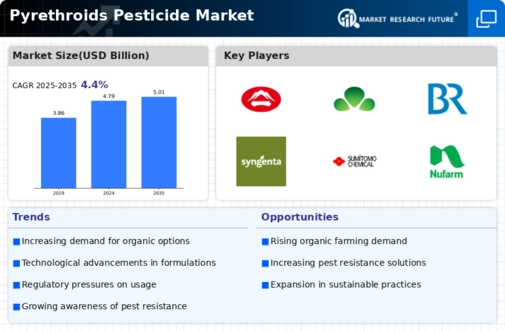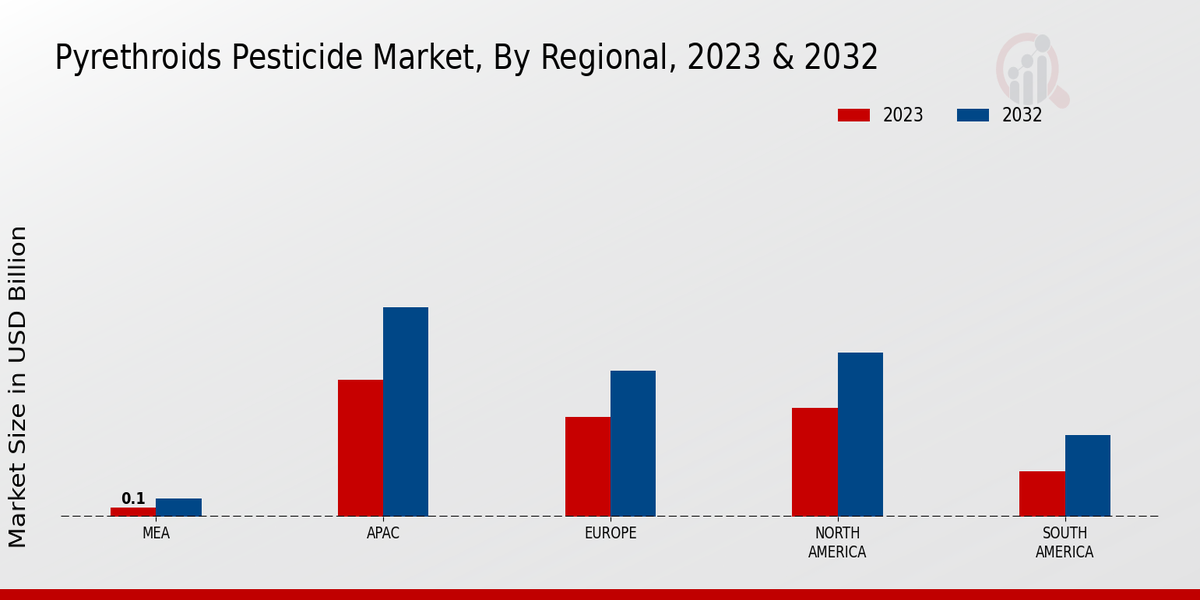Market Growth Projections
The Global Pyrethroids Pesticide Market Industry is poised for growth, with projections indicating a market value of 4.79 USD Billion in 2024 and an anticipated increase to 5.01 USD Billion by 2035. This growth trajectory suggests a compound annual growth rate of 0.41% from 2025 to 2035. Such figures reflect the ongoing demand for effective pest control solutions and the increasing adoption of pyrethroids in various agricultural sectors. The market's expansion is likely influenced by factors such as regulatory support, technological advancements, and the rising awareness of sustainable agricultural practices.
Growing Awareness of Pest Resistance
The Global Pyrethroids Pesticide Market Industry is also driven by the growing awareness of pest resistance among agricultural stakeholders. As pests develop resistance to conventional pesticides, farmers are seeking alternative solutions that provide effective control. Pyrethroids, known for their rapid action and low toxicity to non-target organisms, are increasingly viewed as a viable option. This shift in perception is likely to bolster market growth, as farmers recognize the importance of rotating pest control methods to manage resistance. Consequently, the demand for pyrethroid-based products may rise, further solidifying their position in the agricultural sector.
Regulatory Support for Biopesticides
The Global Pyrethroids Pesticide Market Industry benefits from favorable regulatory frameworks that promote the use of biopesticides. Governments worldwide are increasingly recognizing the importance of reducing chemical pesticide usage, leading to supportive policies for products like pyrethroids. These regulations often encourage research and development, fostering innovation in pesticide formulations. As a result, the market is expected to see steady growth, with projections indicating a value of 5.01 USD Billion by 2035. This regulatory environment not only enhances consumer confidence but also drives manufacturers to invest in the development of safer and more effective pyrethroid-based solutions.
Rising Demand for Sustainable Agriculture
The Global Pyrethroids Pesticide Market Industry experiences a notable increase in demand for sustainable agricultural practices. Farmers are increasingly adopting environmentally friendly pest control methods, which aligns with the global trend towards sustainability. Pyrethroids, being derived from natural sources, offer an effective solution for pest management while minimizing ecological impact. This shift is evident as the market is projected to reach 4.79 USD Billion in 2024, reflecting the growing preference for safer agricultural inputs. Furthermore, the emphasis on integrated pest management strategies enhances the appeal of pyrethroids, as they can be effectively incorporated into broader sustainable practices.
Technological Advancements in Pesticide Formulation
The Global Pyrethroids Pesticide Market Industry is significantly influenced by technological advancements in pesticide formulation. Innovations in delivery systems and application methods enhance the efficacy and safety of pyrethroids, making them more appealing to farmers. For instance, the development of microencapsulation techniques allows for controlled release, reducing the environmental impact while improving pest control efficiency. Such advancements are likely to contribute to a compound annual growth rate of 0.41% from 2025 to 2035. As these technologies continue to evolve, they may lead to increased adoption of pyrethroids in various agricultural sectors.
Expansion of Crop Varieties and Cultivation Practices
The Global Pyrethroids Pesticide Market Industry is positively impacted by the expansion of crop varieties and cultivation practices. As farmers diversify their crops to meet changing consumer preferences and market demands, the need for effective pest management solutions becomes paramount. Pyrethroids offer versatility across various crops, including fruits, vegetables, and grains, making them a preferred choice for many growers. This trend is expected to drive market growth, with projections indicating a steady increase in demand for pyrethroid products. The adaptability of pyrethroids to different agricultural systems enhances their relevance in the evolving landscape of global agriculture.











